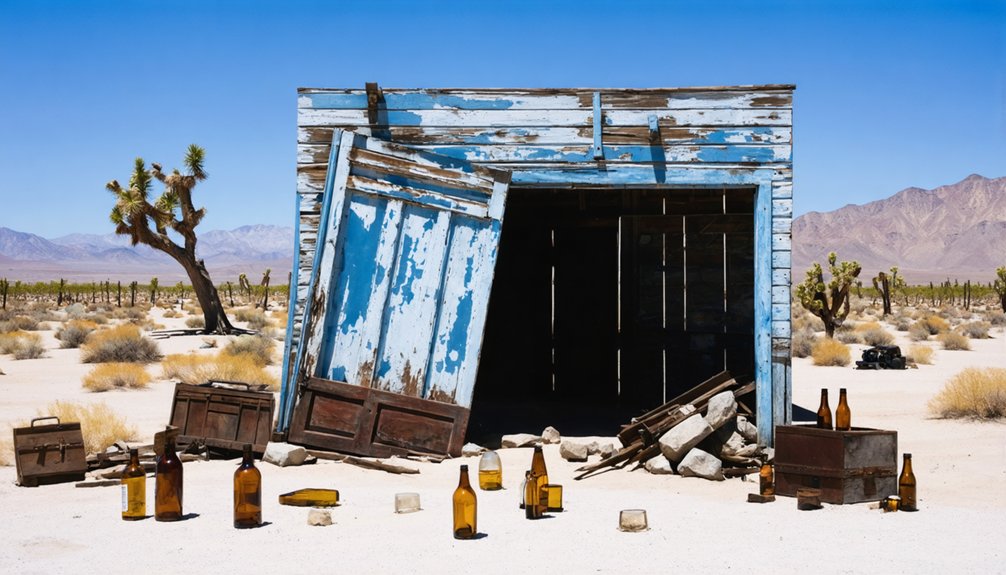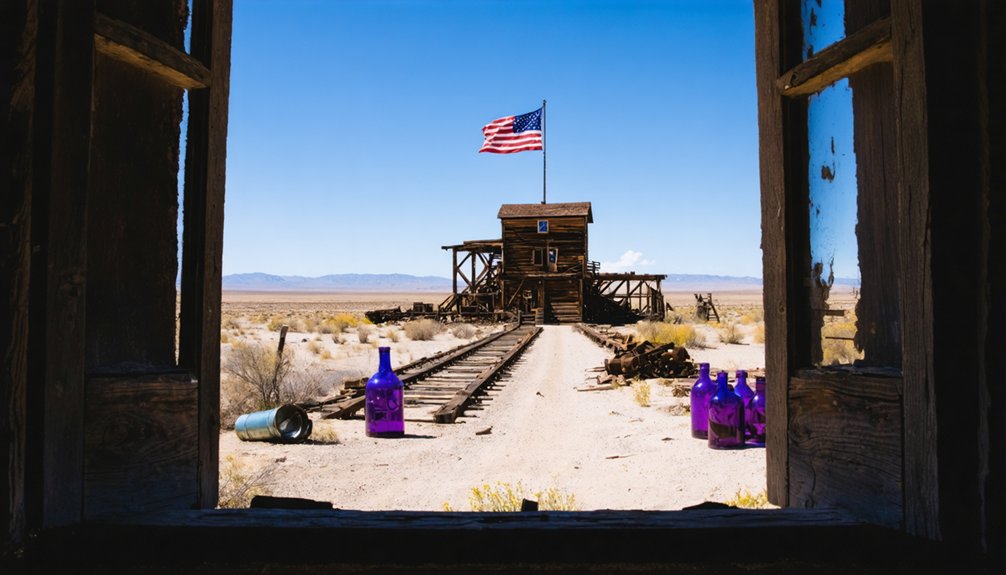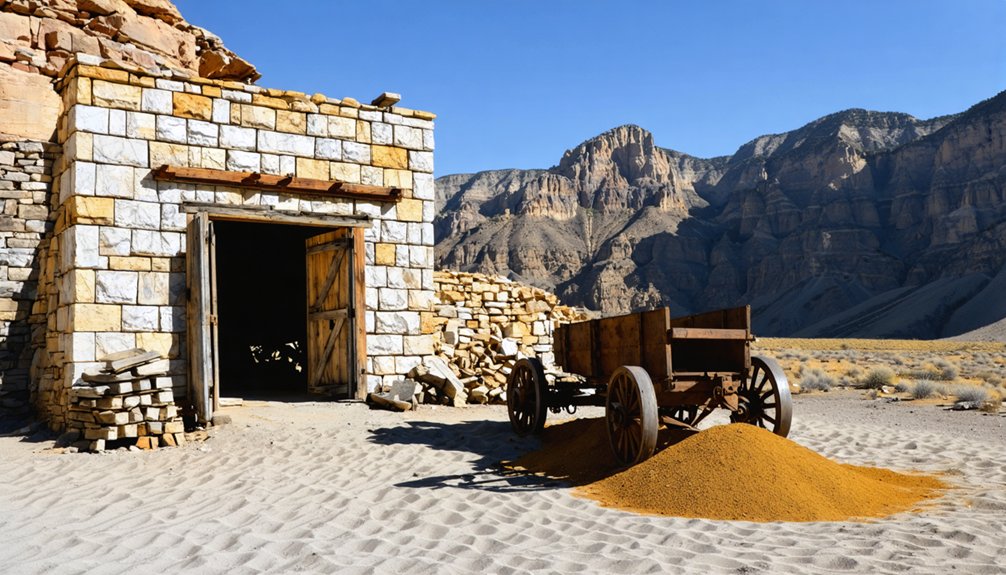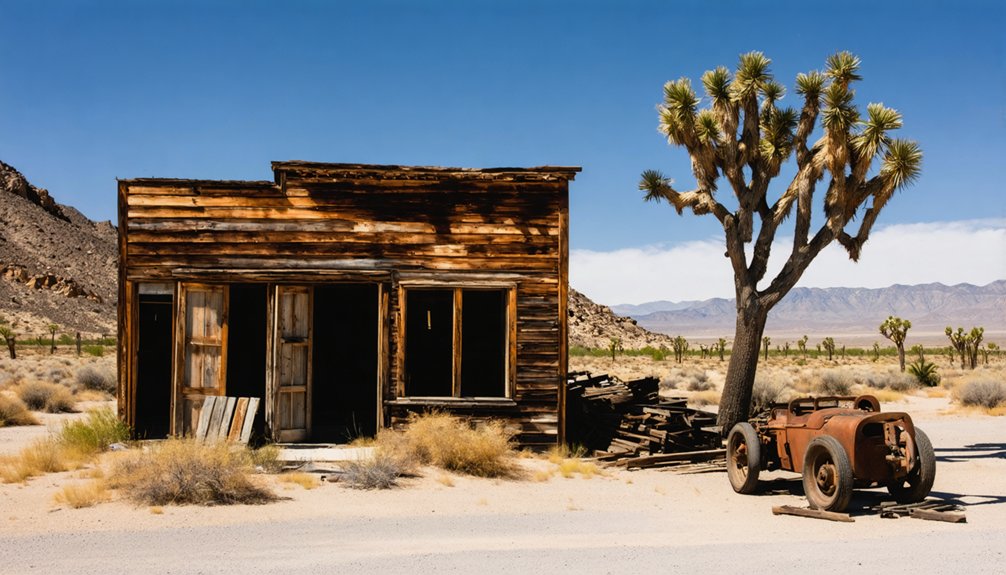Providence, California emerged as a silver boomtown around 1880 when the Bonanza King Mine spurred rapid development. You’ll find this Mojave ghost town once supported 300 residents and produced 2,000 ounces of silver daily through a 20,000-foot underground network employing 150 miners. Its prosperity ended abruptly after a suspected arson destroyed the mill in 1885. The remote ruins today reveal scattered mining equipment and foundations that preserve California’s mining heritage.
Key Takeaways
- Providence was a silver mining town founded around 1880 in the Providence Mountains of California following significant silver discoveries.
- The Bonanza King Mine was the town’s economic heart, producing 1.7 million ounces of silver before a devastating fire in 1885.
- The town supported approximately 300 residents with two general stores, a post office, and three saloons at its peak.
- Providence collapsed rapidly after the 1885 fire destroyed critical mining infrastructure, displaying the vulnerability of frontier mining settlements.
- Today, the ghost town features open-air ruins, collapsed foundations, scattered artifacts, and mining equipment reclaimed by the desert environment.
The Silver Rush That Created Providence (1880-1882)
While the vast Mojave Desert appears inhospitable to all but the hardiest life forms, its rugged Providence Mountains briefly teemed with human activity during the early 1880s when prospectors discovered significant silver deposits.
The rush began when ore-seekers from Ivanpah found rich silver veins along the steep mountain slopes, triggering Providence’s official founding around 1880.
Silver’s gleam drew fortune hunters to Providence, transforming barren mountainsides into a bustling frontier outpost almost overnight.
The town demographics shifted dramatically as miners, investors, and opportunists flooded this remote eastern San Bernardino County outpost. Unlike other mining settlements with similar names, this California Providence ghost town should not be confused with the capital city of Rhode Island or other places sharing the designation.
Mining techniques initially focused on extracting high-grade surface ores using shallow underground works, with rudimentary on-site processing due to transportation challenges. Much like those who participated in the Comstock Lode discovery two decades earlier, Providence miners faced harsh living conditions and limited resources.
Despite the area’s isolation, the exceptional ore quality prompted rapid development of mines, assay offices, and basic infrastructure, briefly stimulating the regional economy before decline set in by 1882.
Inside The Bonanza King Mine’s Operations
When you explore the Bonanza King’s production capacity, you’ll find it reached an astonishing 2,000 ounces of silver daily by 1883, with a total yield of 1.7 million ounces before the devastating 1885 fire.
The mine’s operational efficiency relied on twenty stamp mills where 150 men worked around the clock in three shifts, processing the valuable ore that sometimes reached values of $1,200 per ton.
This intensive extraction system required elaborate infrastructure, including approximately 20,000 feet of underground workings that extended to depths of 800 feet, creating a labyrinthine network that honeycombed the hillside above the mill. After being initially sold for $200,000 in 1882, the mine quickly established itself as a significant economic force in the region. Beyond gold and silver, the operation also extracted secondary commodities including copper, lead, and zinc from the extensive deposit.
Silver Production Numbers
The Bonanza King Mine‘s silver production soared to remarkable heights during its operational prime, yielding an impressive 2,000 ounces of silver daily by 1883. This remarkable output followed the discovery of a rich vein valued at $1,200 per ton in 1882, catalyzing the installation of a twenty-stamp mill to process the abundant ore.
The mine’s total silver production reached $1.7 million before operations halted due to a devastating fire in 1885.
Regional mining statistics reveal the Bonanza King’s dominance:
- Contributed the majority of the 91,662 ounces of silver extracted from the Providence Mountains Wilderness Study Area
- Established the largest underground operation in the district with 20,000 feet of workings
- Generated thousands of tons of tailings, later targeted for retreatment through cyanide-leach processing
The mine’s underground structure featured a 540-foot shaft with five separate levels spaced at 100-foot intervals, allowing for efficient extraction of the valuable ore deposits.
Three-Shift Mining System
Beneath the bustling surface activity of Providence’s Bonanza King Mine lay a sophisticated operational framework that powered its remarkable productivity.
The mine employed a three-shift system, dividing the 24-hour workday into equal 8-hour segments that guaranteed continuous extraction operations.
At peak production, approximately 150 men rotated through this cycle, strategically timed to minimize downtime.
The labor rotation encompassed specialized roles—miners, muckers, timbermen, and machine operators—each contributing to the uninterrupted mining cycle across 800-foot depths and 20,000 feet of tunnels.
This shift efficiency dramatically increased productivity compared to single-shift operations, enabling the extraction of roughly 2000 ounces of silver daily.
Workers earned $3.50 per day for their grueling labor while enduring challenging living conditions with limited amenities in the remote mining camp.
The system’s genius lay in maximizing expensive infrastructure utilization while preventing worker exhaustion, ultimately facilitating the mine’s impressive 1.7 million ounces of silver production.
Mill Processing Technology
Central to Providence’s mining prosperity, the Bonanza King Mine‘s mill processing technology evolved from rudimentary crushing operations into a sophisticated metallurgical complex.
You’d witness the progression from a 10-stamp mill to a 20-stamp facility capable of processing 2,000 tons of ore—a demonstration of rapid milling advancements during the 1880s.
- Initially, stamps lifted and dropped repeatedly to crush silver and lead-bearing ore, creating recoverable materials valued at $1,200 per ton.
- After the devastating 1885 fire, operations eventually resumed with upgraded ore extraction techniques.
- By the 1970s, the Brownstone Mining Company implemented agitation-vat cyanide-leach processing to recover metals from tailings.
The mill’s ruins—timber fragments, foundations, and tailings piles—preserve the technological footprint of Providence’s industrial mining heritage, documenting the evolution of metallurgical innovation in California’s mining frontier.
Daily Life In A Company Mining Town
Life in Providence revolved entirely around the rhythms and demands of the Bonanza King Mining Company, which exerted near-total control over residents’ daily existence. You’d have found yourself living in rudimentary stone cabins or tents, working grueling shifts in hazardous conditions while paying for necessities with company scrip at company-owned stores—a system designed to limit your economic independence.
Social networks formed through necessity in this isolated desert outpost. After enduring twelve-hour shifts underground or at the stamp mills, you might’ve sought brief respite at one of three saloons, the center of recreational life.
The harsh environmental conditions and shared struggles against company control fostered tight bonds among workers, creating community connections despite the transient nature of the mining population.
Exploring The Remaining Ruins Today

Today’s Providence stands in stark contrast to its once-bustling past, with only scattered ruins and mining tailings marking where the thriving company town once operated.
Unlike preserved ghost towns like Bodie, Providence has succumbed to natural decay, with no intact buildings remaining. Similar to how a fire in 1932 destroyed 90% of Bodie’s structures, Providence’s original buildings have not survived the test of time. The Bonanza King Mine site offers the most recognizable features amid the barren landscape.
Your desert exploration will reveal:
- Collapsed foundations and broken mining equipment partially reclaimed by the environment
- Scattered artifacts and rusted tools that tell stories of industrial ambition
- Open-air ruins suitable for photography with minimal interpretive signage
Access requires traversing desert roads to this remote location, where abandoned structures have largely returned to the earth. Located in San Bernardino County, Providence shares its regional history with other notable ghost towns like Amboy and Calico.
This unpreserved state offers a raw, unfiltered glimpse into the ephemeral nature of frontier mining settlements.
The Rapid Rise: Building A Town From Nothing
Following the discovery of substantial silver veins in 1880, Providence transformed from barren desert terrain into a burgeoning settlement with remarkable speed, exemplifying the phenomenon of instant urbanization that characterized Western mining booms.
The town’s planning reflected practical mining considerations, positioning structures near the 10-stamp mill and Bonanza King Mine despite challenging steep terrain.
By 1882, community dynamics had evolved to support approximately 300 residents with essential infrastructure including two general stores and a post office. The 20,000 feet of underground mine workings mirrored the above-ground development’s ambition. The gold mines discovered south of Foshay Pass in 1882 further diversified the area’s mineral wealth.
Providence’s economic foundation relied entirely on silver extraction, creating a precarious town stability that would prove fateful when the mill burned in July 1885, instantly undermining the community’s existence—a vulnerability common to single-industry boomtowns.
Peak Production Years: When Silver Flowed Freely

When the Bonanza King mine began yielding its first significant silver ore in 1880, it initiated a remarkable period of prosperity that would define Providence’s brief but luminous existence.
By 1883, daily silver production reached 2,000 ounces, transforming Providence into a thriving company town. Underground workings expanded rapidly, with shafts reaching 800 feet at Bonanza King and 1,100 feet at Providence mine by 1886. The Champion Mine’s shaft depth reached 2400 feet by 1902, showing the extensive development of the area’s mining operations.
- The Bonanza King produced approximately 1.7 million ounces before a devastating fire in 1885
- High-quality ore valued at $150-$200 per ton fueled the local mining legacy
- Advanced processing technologies like chlorination revolutionized silver market extraction capabilities
The Champion-Providence group’s remarkable production—estimated between $8-20 million—cemented the district’s significance in California’s mining history, with operations continuing into the early 1900s.
The Devastating Fire of 1885 And Its Aftermath
The fire that consumed Providence’s main mill in mid-1885 marked a catastrophic turning point in the town’s trajectory from prosperous mining hub to abandoned ghost town.
Evidence of sabotage—cut fire hoses and disabled alarm bells—suggests a deliberate attack on the town’s minimal fire safety infrastructure.
Without its primary ore processing facility, Providence’s mining operations quickly collapsed. A smaller 5-stamp mill erected at the Perseverance Mine in 1886 proved economically insufficient to sustain the community.
Jobs vanished, triggering an exodus of residents.
The disaster exposed Providence’s vulnerability and lack of community resilience planning typical of frontier mining settlements.
Today, the mill fire’s legacy persists in the silent ruins scattered across the landscape—tangible reminders of how quickly prosperity can vanish when essential infrastructure is destroyed.
Providence’s Place In Mojave Desert Mining History

Situated within a broader tapestry of Mojave Desert mineral exploration that began in 1863, Providence emerged as a significant silver mining center following George Goreman and P. Dwyer’s discovery of high-grade silver ore.
Providence’s economic impact extended beyond its immediate boundaries, generating wealth that attracted substantial investment despite harsh desert conditions.
- The town represented a critical node in the Mojave mining economy with production exceeding one billion dollars in today’s silver values.
- Providence’s development coincided with evolving mining legislation that facilitated the staking of over 1,200 claims in the surrounding mountains.
- The Bonanza King operation, with its 20,000 feet of underground workings, exemplified industrial-scale extraction methods that would define later desert mining ventures.
Safety Concerns And Preservation Challenges
While Providence’s mining legacy represents a significant chapter in Mojave Desert history, today’s visitors face substantial dangers among its deteriorating remnants.
You’ll encounter collapsed ceilings, unstable railings, and fire-damaged structures that pose immediate physical threats. The town’s remote location compounds these risks, as emergency services can’t quickly reach you if injured.
Preservation efforts struggle against persistent vandalism and natural deterioration. Despite attempts at implementing safety measures like fencing and warning signs, trespassers continue damaging historical structures.
The harsh desert environment accelerates decay, while limited funding hampers restoration work.
If you’re determined to visit, prepare thoroughly for desert conditions, respect boundaries, and understand that each act of vandalism permanently diminishes this fragile historical site.
Your responsible exploration helps guarantee Providence’s story survives for future generations.
The Geological Treasures That Drew Miners To Providence

Extraordinary geological wealth beneath Providence’s rugged terrain sparked one of the Mojave Desert’s most significant mining rushes in 1880 when prospectors George Goreman and P. Dwyer discovered silver-bearing rock assaying between $640-$5,000 per ton.
This remarkable mineral concentration justified extensive mining investment, culminating in the sale of the Bonanza King mine for $200,000 in 1882.
- The primary operation produced 2,000 ounces of silver daily by 1883, with 20,000 feet of underground workings eventually honeycombing the hillside.
- High-grade ore valued at $1,200 per ton attracted a twenty-stamp mill and 150 workers operating in three shifts.
- Beyond silver, the district yielded valuable lead, gold, and iron deposits that sustained mineral exploration well into the twentieth century.
Frequently Asked Questions
Were Any Notable Outlaws or Gunfights Recorded in Providence?
No, historical records don’t document any Providence gunfights or Providence outlaws. The town’s brief existence (1880-1886) and small size prevented it from attracting notorious criminals or violent confrontations.
What Happened to the Residents After Providence Was Abandoned?
Dust settled on empty doorways as you’d watch families scatter to nearby mining towns. Post abandonment impacts included widespread resident relocations to San Bernardino County cities, where they sought new economic opportunities as Providence’s legacy faded.
How Did Miners Handle Water Supply in This Desert Location?
You’d find miners employing strict water conservation practices, hauling supplies from distant springs, constructing cisterns, and adapting dry washing mining techniques that required minimal water for ore processing in this harsh environment.
Are There Any Ghost Stories or Paranormal Reports From Providence?
You won’t find documented ghost sightings or haunted locations associated with Providence. Unlike other abandoned mining towns, this site lacks verified paranormal reports despite its eerie ruins and isolated desert setting.
What Transportation Methods Connected Providence to Other Settlements?
You’d have traveled to Providence primarily via Southern Pacific railroad connections that linked this mining town to regional settlements. Local wagon trails provided secondary transportation routes before the railroad’s eventual abandonment.
References
- https://en.wikipedia.org/wiki/Providence
- https://mojavedesert.net/mining-history/chronology.html
- https://goldexplorers.com/bonanza-king-mine/
- https://en.wikipedia.org/wiki/List_of_ghost_towns_in_California
- http://harryhelmsblog.blogspot.com/2008/04/ghost-town-of-providence-california.html
- http://freepages.rootsweb.com/~gtusa/history/usa/ca.htm
- https://www.legendsofamerica.com/ca-harrisburg/
- https://digital-desert.com/ghost-towns/umd/providence.html
- https://www.telegram.com/story/opinion/columns/2017/10/12/al-southwick-great-silver-rush-of-1859/18324636007/
- https://digital-desert.com/providence-ghost-town/



